This Myanmar travel guide is regularly revised. Alongside access to regular tourism updates via affiliated tourism groups and businesses, ensure that this article remains the most comprehensive overview of visiting Myanmar on the web. You will also find helpful resources and discounts for travel in Myanmar, at no extra cost to you.
Is it Ethical to Travel in Myanmar Right Now?
Check here for news articles and updates on the Rohingya Crisis in Myanmar, which is posing a difficult moral choice about whether is it ethical to visit Myanmar at a time where over half a million Rohingya refugees have had to flee the country because of violence.
Choosing to travel there at this time is, of course, a personal decision since other regions in Myanmar remain separate from this conflict. Still, it is good to be well-informed about the situation, political tensions and the Myanmar government’s actions which are not reflective of its people overall.
Myanmar Travel Guide – Foreword
Travel to Myanmar (or travel to Burma, if referring to its former name) is hot on the Southeast Asia travel trail now, but as a country which has only recently opened its doors to tourism over the past decade, travelling here means facing many challenges that you do not necessarily encounter on the same scale as other countries in the region.
Infrastructure is only just beginning to spring into life and the art of the tourist trade is still in the developing process, yet every second of the long journey times, the energy expended in the daily frustrations and the patience and sign language needed to cross the language barrier is worth it for the rewarding experience you will have travelling in Myanmar – a beautiful and still very much untouched country.
Be prepared for the different kind of travel you will encounter in Myanmar, and don’t believe the scaremongering about the ridiculous expense and immense difficulties that are putting many people off travelling here.
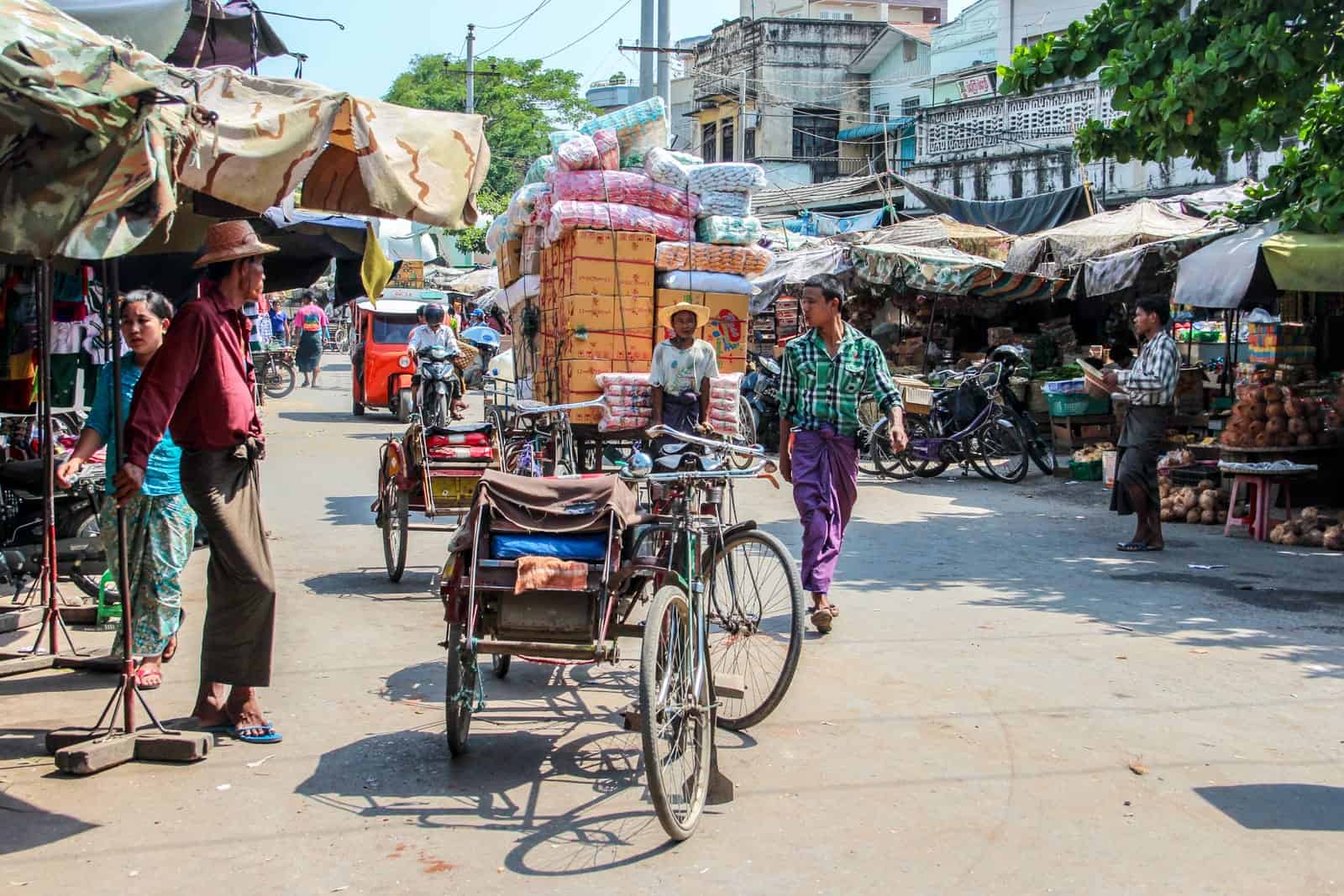
Myanmar Travel Guide – A Different Way of Travelling in Southeast Asia
The beauty of being in Myanmar is in not knowing what will happen and in the understanding that both you as a traveller, alongside the local people are helping to bring about a new beginning. Tourism in Myanmar is a new lifeline, providing it does not eventually ruin the country, which is a current concern.
Here you will find a comprehensive Myanmar Guide that I pulled together after travelling through the country for one month. A resource which I hope is useful, before you jump headfirst into a place which Kipling described as, “unlike any land you know about”.
Is Myanmar Safe Now?
More so in light of the recent Rohingya Crisis, this is now a more common question. Generally, a trip to Myanmar is considered safe with no tourist-related violence having been reported in the known traveller circuit of Yangon, Bagan, Inle Lake, Hsipaw, Pyin Oo Lwin, Mandalay and the Mergui Archipelago.
I never encountered any issues and the only time I felt a little uncomfortable was when some of us were travelling to a recently opened part of the country and we were clearly under some sort of surveillance (more so at bus checkpoints) being new in town. I never once felt in danger, and nor did I feel in danger despite the curfews in some places.
I was always advised to avoid any protests and demonstrations and be more cautious should there be a military event, celebration or rally. In short, don’t get involved.
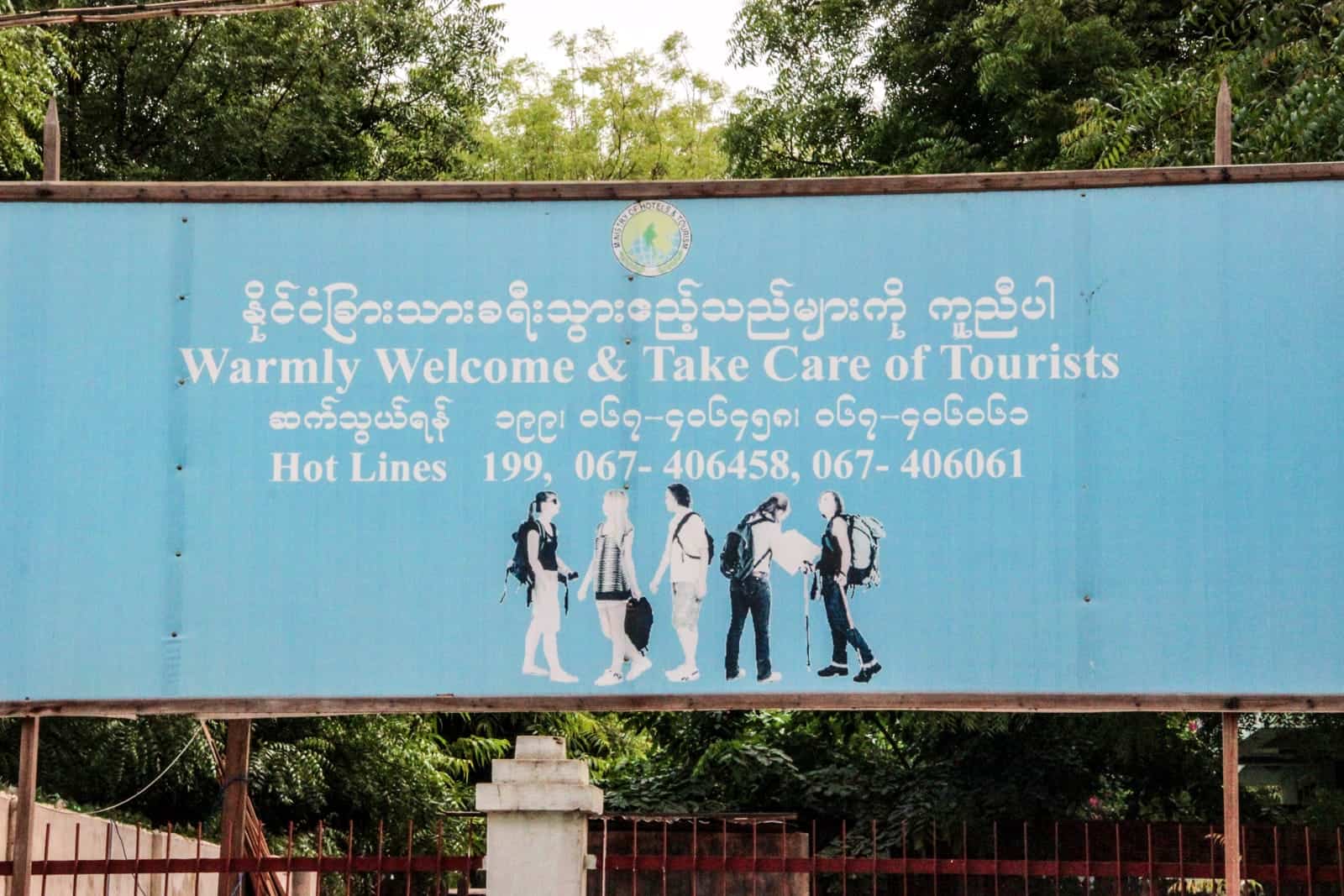
Tourists are safe in Myanmar and looked out for
Heightened Caution in Rakhine State
While no foreign office or state departments are placing high warnings or statements suggesting avoiding travel to Myanmar unless necessary, there is updated advice since the end of 2017 does show a warning for significant risk of violence in the Rakhine state and the northwestern region of the country.
Like with any political situation, it is wise to stay up to date with developments and the advice of your foreign office in case of a Myanmar travel warning. The UK Foreign Office, for example, advises being more vigilant on the anniversary of the attacks in Rakhine on 25th August 2017.
Avoid Land Borders
It is also advised (including the official land border crossings) to avoid the border areas, especially those with Thailand, Laos and China (but also India and Bangladesh) due to drug smuggling activity and military and ethic militia activity where regular armed clashes take place.
Myanmar is still plagued by internal conflicts, and while many of the areas where these take place are completely off-limits to tourists without a permit anyway, it is good to stay aware of exactly where you shouldn’t be visiting. Here is an overview of what the UK Foreign Office state in their travel advice:
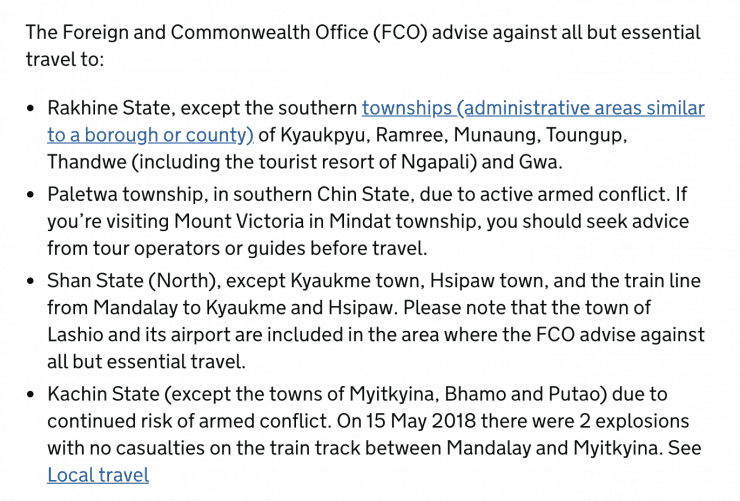
Burmese People Are Welcoming to Tourists
Burmese people are the most genuine, friendly, warm-hearted and amazingly beautiful people I have ever met.
Not one will turn you away when you need help and hardly anyone will try to short change you or be cheeky in a transaction.
They are so fascinated by the presence of outsiders, that you can see the sheer excitement on their faces. Smile and say hello, shake hands, hug, exchange e-mail addresses and revel in the wonderful reaction you get back.
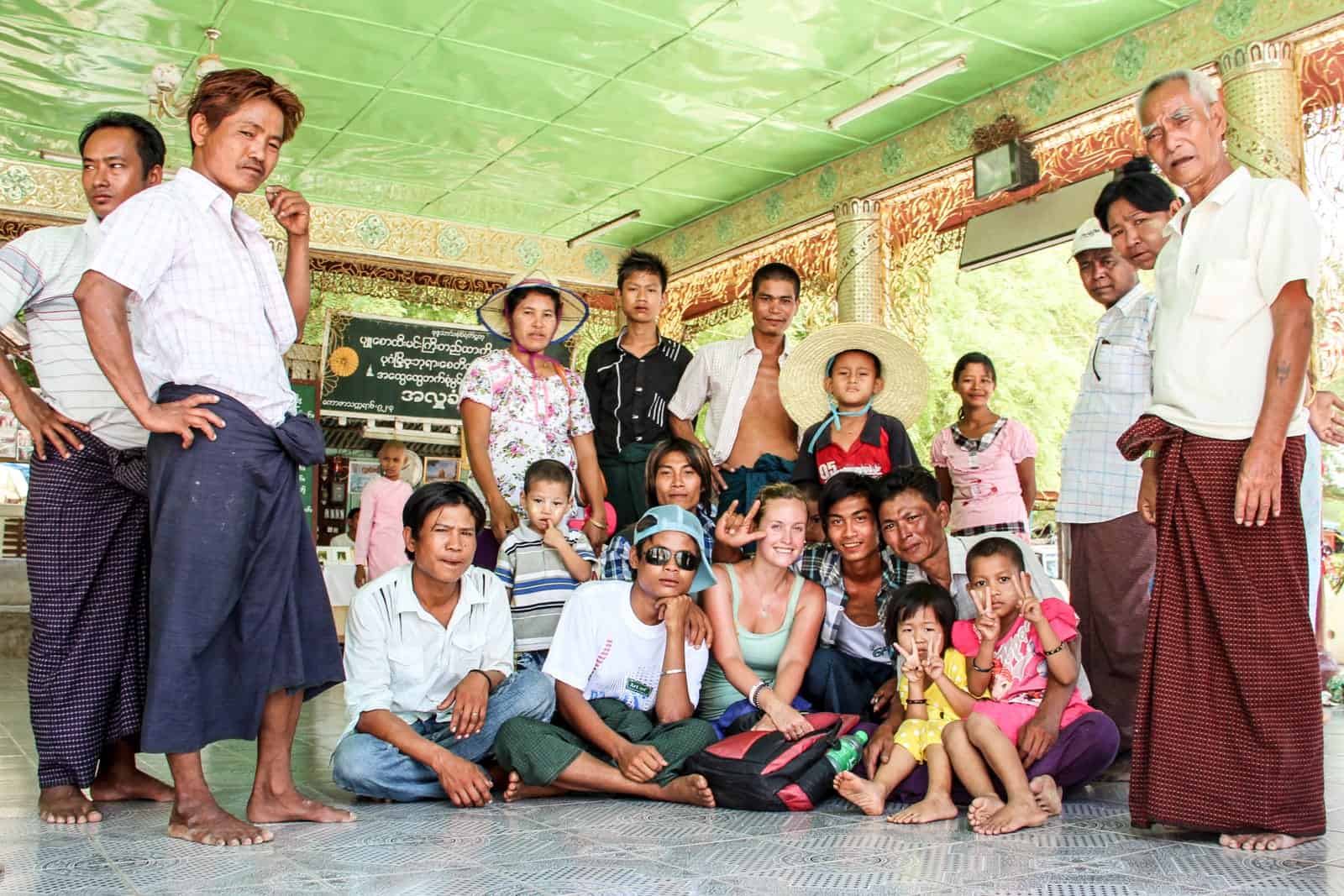
You are never without Burmese friends
Myanmar or Burma? Why Did it Change Its Name?
The country formally known as Burma gained independence in 1948 from occupying forces, but it wasn’t until 1989 that the ruling military junta (that retains majority power today), changed the country’s name from Burma to Myanmar following a military coup.
Myanmar vs. Burma – is it the same? Politically no. In tourism, yes.
Politically, the name Burma was seen as a relic of the country’s former British colonial past, and Myanmar as more inclusive of the many ethnic groups in the country. Other names were also changed, which is why you will see Rangoon now referred to as Yangon.
For tourism, to travel Burma is to travel Myanmar. Same same, as they say in Southeast Asia.
Both Burma and Myanmar are still used interchangeably, on the ground and the world stage. This article breaks down the changes, what you ‘should’ say and the question: does it even matter?
Who Can Travel to Myanmar? Visas and How to Get There
Visas for Myanmar can be obtained online from the official governmental eVisa website and costs $50 (or $56 for an express service).
Flights to Myanmar are the usual option for travellers as the first mode of entry, with regularly scheduled services from Bangkok. But, considering where Myanmar is located – bordered by China to the North and Northeast, Thailand and Laos to the east and India and Bangladesh to its west – there are multiple avenues for land entry also, although not all of them are advised due to safety.
Regardless, you must specify a “Port of Entry” in your online application which denotes how you will be getting to Myanmar. You will be given a list of options, from which you will need to choose one of the following:
Myanmar Designated International Airports:
- Mandalay (located right in the middle of Myanmar)
- Yangon (located in the south)
- Nay Pyi Taw (situated in between Mandalay and Yangon)
Crossing at Land Border Checkpoints:
- Tachileik (in the Shan State of eastern Myanmar on the border to northern Thailand)
- Myawaddy (in the Kayin State of southeastern Myanmar on the border to western Thailand)
- Kawthaung (in the southernmost part of Myanmar, in the Tanintharyi Region on the border of the Thai Peninsula and the cluster of islands)
- Tamu (in the Sagaing Region of northwestern Myanmar on the border to northeastern India)
- Rih Khaw Dar (a six-hour drive from the border village of Khawmawi in the northwestern Chin State of Myanmar on the border of Southeastern India)
In reality, you can enter Myanmar at any designated “Port of Entry” but it is best to stick to the one you originally stated if possible to prevent any hold up in the processing of your visa upon arrival.
You can exit at any of the International Airports and Land Border Checkpoints since your exit point does not need to be stated up-front. Additionally, you may exit at the Htikee Land Border Checkpoint, although entry from here is not possible.
While a month of travelling is not possible for everyone if you can make the most of your 28-day visa for a Myanmar trip, do. This is not a country that is seen in a few days or a week, much like you can do the key highlights in the more easily navigable Cambodia and Vietnam. This is a huge country and travel times are long, plus it takes times to get to grips with how things work here and understanding the people, the culture and the political climate. Spend at least two weeks here if you can – skimming this incredible landscape is an absolute waste.
Best Time to Visit Myanmar
There are typically three seasons in which you can visit Myanmar:
- October to March: Dry, winter season
- March to May: Hot, summer season
- May to October: Wet, rainy season
Taking into account the climate and tourism footfall, I recommend the following seasonal breakdowns.
I want to go to Myanmar when there is cooler weather
Downside: Lots of tourists
The popular, high season is November to February when the weather is warm but not stifling, and attracts the greatest number of visitors.
This, in turn, makes the limited accommodation options tricky to secure and will mean trying to book ahead or face paying out for the more expensive options left over.
I want to go to Myanmar when it is not so crowded with visitors
Downside: It’s stifling hot
March to May is the time when the temperature rises in Myanmar and impending rains are due. I choose to travel in May, as the monsoon season typically starts in June.
I wanted to arrive just before the rains, where there was a limited number of tourists and I could walk into a guesthouse and get a room without any problems. The only downside to this time of the year is that it is incredibly hot and I mean disgustingly, sweaty hot.

No matter what time of the year you visit Myanmar, you are rewarded with incredible views
The Best of Myanmar – Where to Go and Things to Do
You won’t be short on options about where to go in Myanmar, and a traveller path has been laid. The loop between Yangon and Mandalay is both easily accessible and well established for good reason, so don’t be put off by those Myanmar destinations listed as tourist spots. What to see in Myanmar depends entirely on your own desired ration of culture and adventure, since the country is filled with everything from city exploration, multi-day hikes, cycling tours and river journeys. And with Myanmar’s location next to the Andaman Sea (and the Bay of Bengal), beach time and diving are also on the agenda.
Carve your path.
Visit Yangon
While no longer the capital of Myanmar, Yangon (formerly Rangoon) is not short on sights. A city of British colonial architecture and modern developments mixed with the gleaming Buddhist temples and pagodas, you might be surprised how long you want to stay. Highlights include the Shwedagon Pagoda, the colonial-era Kandawgyi Lake, the Chauk-htat-gyi Buddha Temple showcasing one of the country’s largest reclining Buddha statues.
READ MORE: Riding the Yangon Circular Train in Myanmar
Days Trips from Yangon
Bike in Bagan

Bagan is a city filled with over 2,000 temples built between the 9th and 13th centuries. Hire a bike for the day and explore as many as you can, and clamber temple heights for sunrise and sunset. Many travellers stay for two days to cover the temple grounds and have adequate rest from doing so in the heat.
READ MORE: Exploring Bagan – The Vast Temple Town of Myanmar
Day trips and Tours in Bagan
Take a Boat Tour on Inle Lake
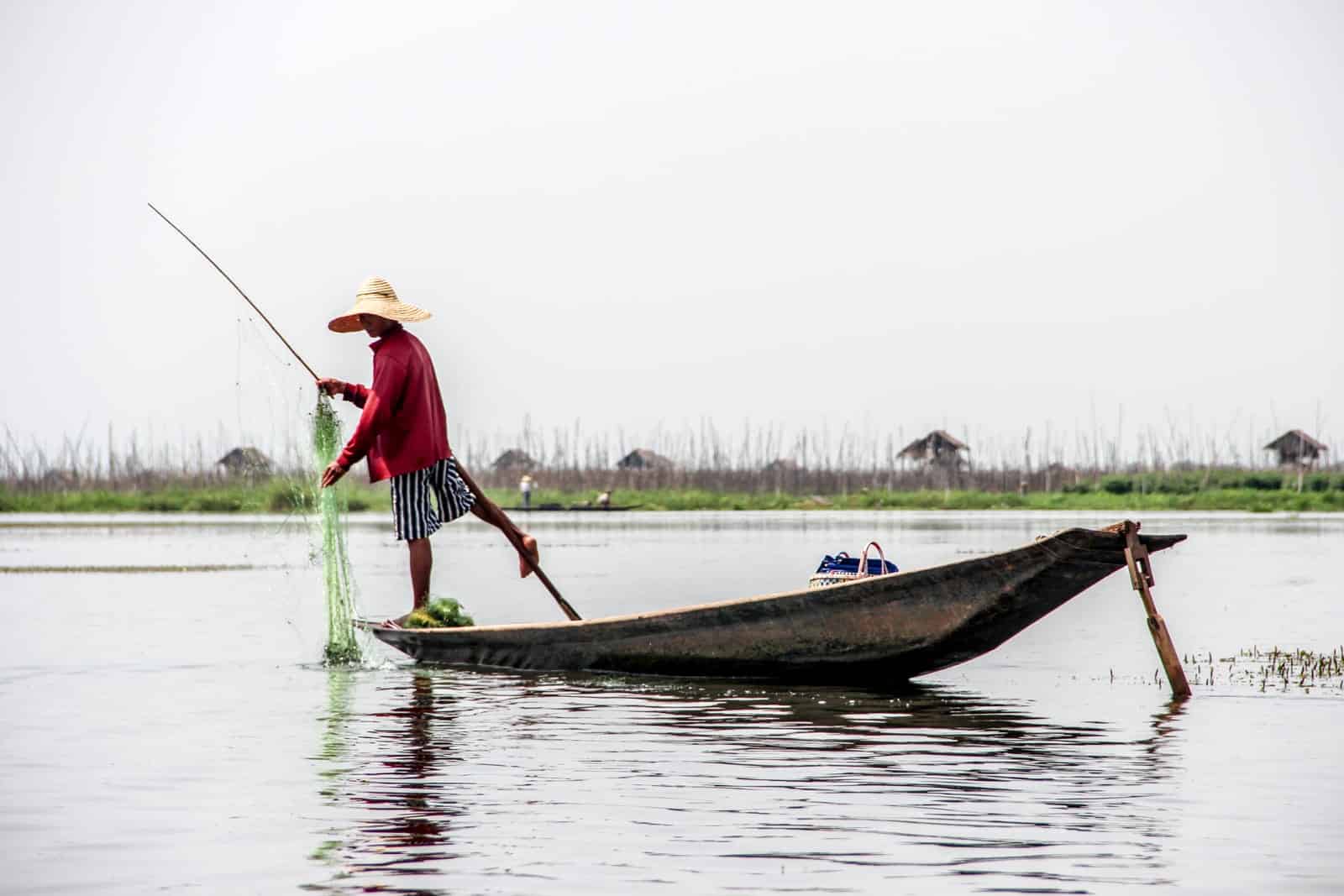
The second largest lake in Myanmar is located in the northern Shan State and is a huge basin, snaking off into tiny canals with miniature hand-built dams and floating gardens. People come here to see the fisherman using traditional fisherman methods, by operating the oar using one leg.
READ MORE: Reflections on Inle Lake: Myanmar’s Biggest Tourist Attraction
Day Trips and Tours in Inle Lake
Hike Hsipaw to Kalaw and Train to Pyin Oo Lwin
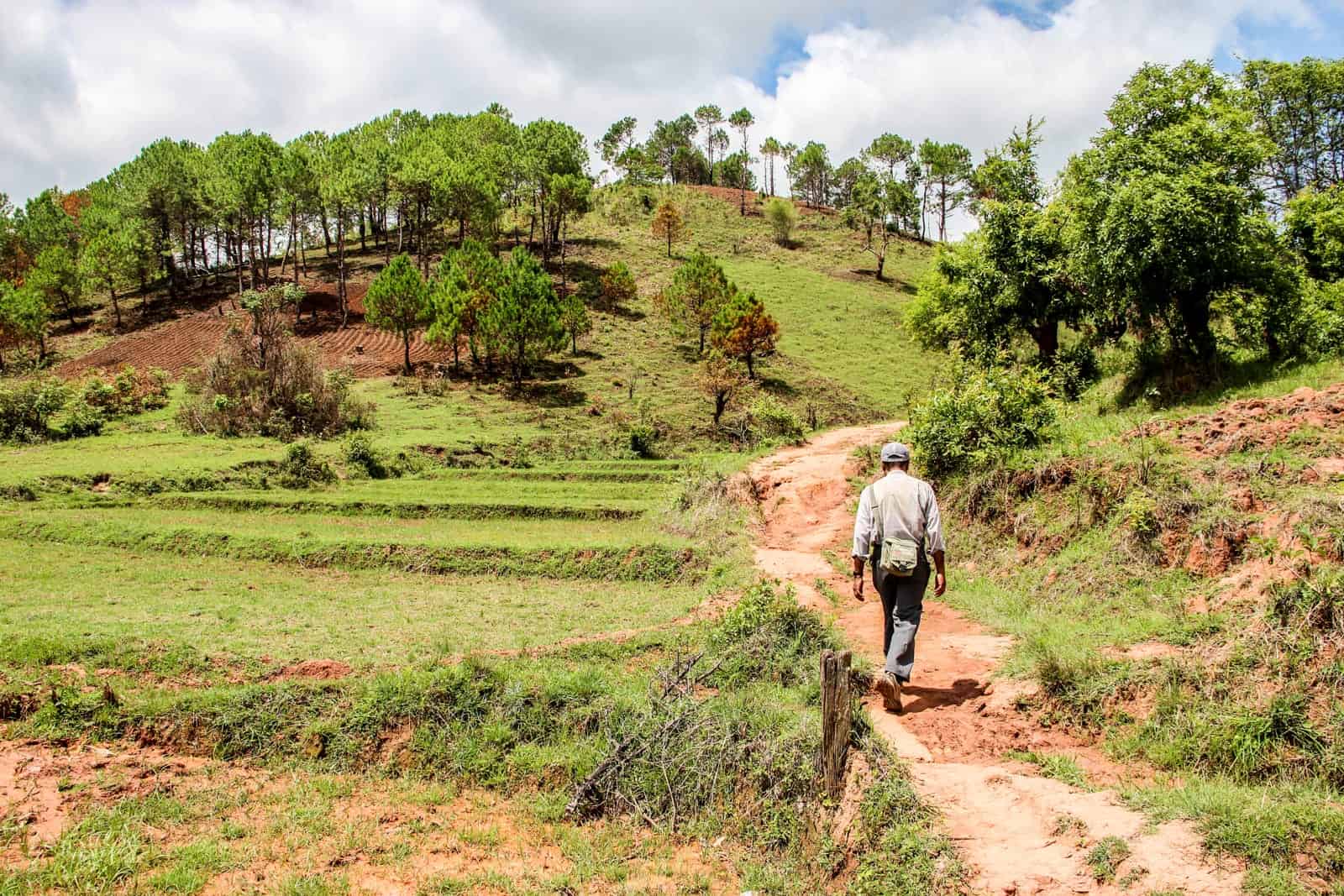
Hsipaw is known for its hiking trails, where I took on a three-day trek through this rural region of Myanmar towards Kalaw. Following that, the three-hour train journey from Hsipaw to the former colonial summer hideaway of Pyin Oo Lwin, across the Goteik Viaduct is a heart-racing journey and an unforgettable experience in Myanmar.
READ MORE: Riding the Highest Railway Bridge in Myanmar – Crossing The Goteik Viaduct
Day Trips and Tours in Kalaw and Pyin Oo Lwin
Explore Mandalay
A bustling, dusty city in a river valley landscape surrounded by mountainous plains and rice paddy fields, Mandalay is a perfect combination of city exploration and countryside adventure.
READ MORE: Cycling in Mandalay – Finding Kipling’s Rural Myanmar
Bike Tours in Mandalay
Day trips from Mandalay
Get to the Mergui Archipelago
This Archipelago, off the far south coast of the long peninsula mainland of Myanmar, has hundreds of islands. While many come here for pristine beaches, it’s coral reefs attract divers to the region for undiscovered territory. The Archipelago used to require a government permit for visit, but do double-check which areas are now open and which may still be subject to permission.
Be Prepared to be ‘Templed Out’
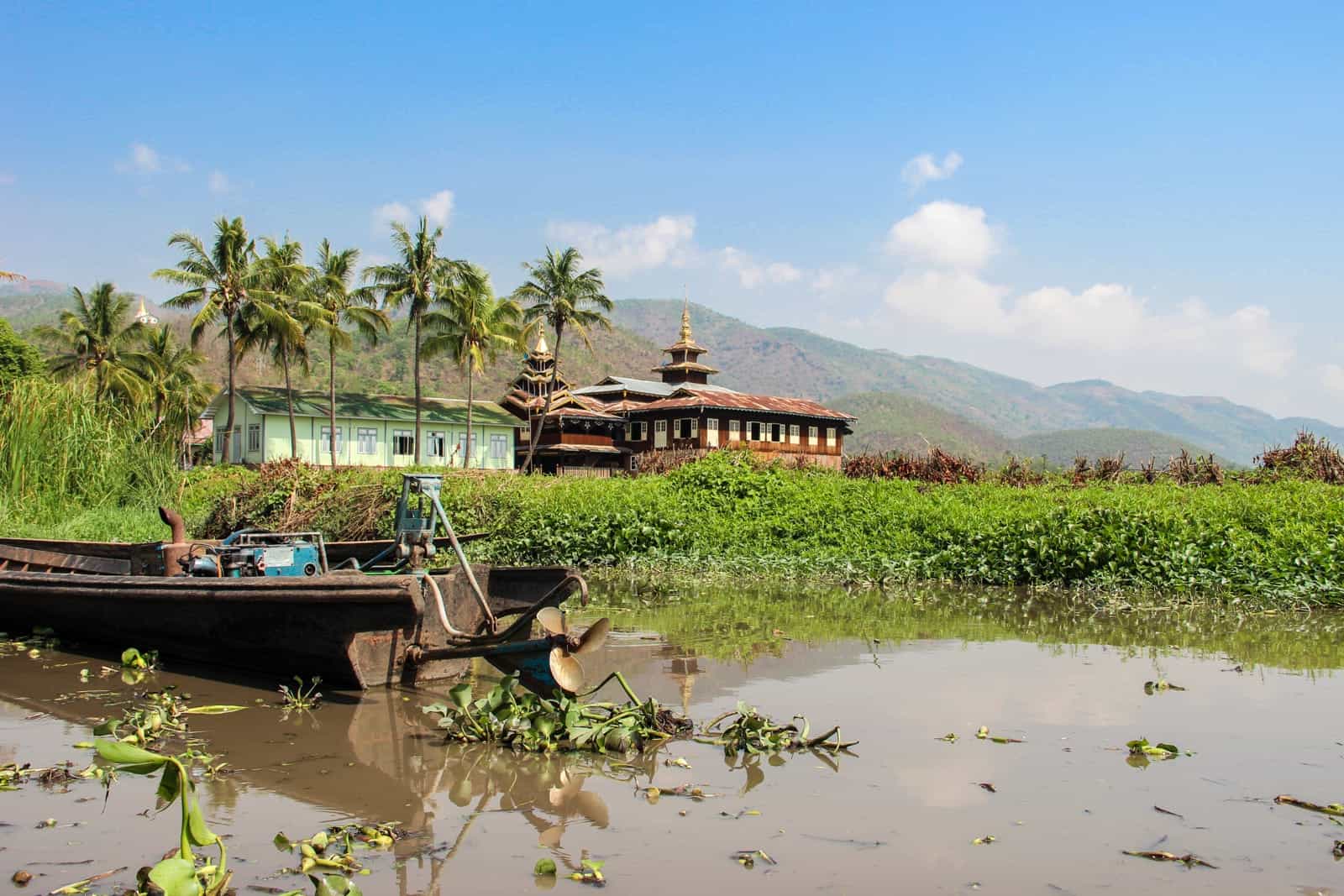
Myanmar is not short on temples
Yup, the Southeast Asia fatigue strikes again. In Myanmar, a temple is going to greet you on every corner, or more specifically here, a golden stupa/pagoda/pyre. While beautiful, it can be lethargic stumbling upon too many as they look similar bar slight differences in height and decoration. If limiting your pagoda hopping (locals tend to love showing off the pagodas in their towns if showing you around), make a visit to the Shwedagon Pagoda in Yangon and the unique temples complexes of Bagan your absolute must-sees from the bunch.
Money in Myanmar – Currency Exchange and ATM’s
You Need Brand New Dollar Bills for Myanmar
The need to have crisp, un-creased, unmarked, brand new US dollar bills for Myanmar remains. Since the vast majority of people fly into Myanmar from Bangkok, this seems to be a popular place to get hold of the bills. I changed my money at a currency exchanger called SuperRich in Silom and the whole process took around an hour. If you have time, withdraw all your money in Thai Baht, as using your card to get dollars means having to pay a 2.5% commission/ fee on top, compared to the 150 baht (approximately £3) standard ATM withdrawal fee.
When exchanging in hard cash, there is a small fee for every $10, but this still works out cheaper than the ATM and/or using your card fee.
Exchanging US Dollars to Myanmar Kyat
You can exchange your dollars into Myanmar Kyat when you get to your hotel or guesthouse, in a local bank or at the airport – the latter not always being not as good a rate as the others. Refrain from using the money exchangers on the street who try to lure you with higher rates – it is said they cleverly short change you (which is easy as you get a LOT of Kyat notes for very little Dollars). Unless you are willing to count your money three times, then it’s not worth the hassle.
ATM’s in Myanmar
The stories are true – Myanmar is now equipped with a sporadic scattering of ATMs. Dishing out Kyat, there are ATM machines at the airports and I found a handful of ATM’s in Yangon (including at the most famous spot in town – the Shwedagon Paya) and Mandalay city centres, as well as in Nyaung U in Bagan.
However, there are ATM fees, where you will likely be charged a small fee of around $5 for the privilege of each withdrawal.
You might find ATM’s in the smaller towns in Myanmar, but don’t leave it this late to stock up on cash, just in case. It has been known for ATMs to stop working or run out of cash in more remote areas.
When to use Dollars and when to use Kyats
Typically, dollars are used for paying for your accommodation in Myanmar and some forms of transport, such as internal flights. Everything else from food, street snacks, tuk-tuks and guides are paid for in kyat.
Should you find yourself low on dollars, most locals are happy to accept kyat instead, but you will be paying more – while the current exchange rate is approximately 1450 kyat to the dollar, many will simply round your dollar up to say 1,500 kyat.
When I was travelling, the exchange rate was around 800-900 kyat to the dollar, and they rounded the conversion to 1 dollar = 1,000 kyat. So, when a room for the night was $25, they typically asked for 25,000 kyat, rather than working to an official exchange rate. I was losing a small chunk each time.
As it currently stands, ’rounding up’ with the current exchange rate means you won’t be losing too much.
Is Myanmar Expensive? Budget Travel Tips
A Myanmar trip can be a budget one. On average I spent between $30-$40 a day in Myanmar, including the cost of my accommodation and transport. I ate street-food where I could find it or ate at local restaurants.
The average cost of a budget hotel room in Myanmar is $25 and a dorm bed around $10.
Food and drink in Myanmar can fall within a reasonable $10 per day budget. A beer will set you back $2.
Internal flights will be your most expensive purchase, with prices from $100+.
Myanmar is expensive only if you choose to travel that way. For example, if you choose to stay in top-end places and eat at expensive establishments (which are normally military / government-owned) not only are you spending more, but your money is not being spent wisely (see ‘Responsible Travel’ below).
Being aware of your money and how much you are spending will ensure that you spend the same amount here as you would in any other part of Southeast Asia.
READ MORE: How Much Does it Cost to Travel in Myanmar?
Responsible Travel in Myanmar – Know Who You are Supporting
If you are a luxury traveller wanting to stay in and dine at the top end, government-owned hotels then you will not be travelling responsibly in Myanmar. Each to their own, but if you travel irresponsibly here then you probably should not be coming at all.
Traveling Myanmar means contributing to the wave of great change here. With locals given more rights to trade privately, we must support them rather than line the pockets of the corrupt and controlling system. While your guesthouses will not always be the cleanest or most comfortable, or your food the most delectable, remember one thing – local support is the greatest thing you can give during this exciting stage of development in Myanmar. For many, it will be time to embrace a new way of travelling.
I choose to eat and drink at local establishments and bought items from local markets and street vendors. Not only did I feel I was giving something to those who deserved it most, but it was also the ideal opportunity to meet and get to know the local people, which in itself forms one of the greatest memories of travelling in Myanmar.
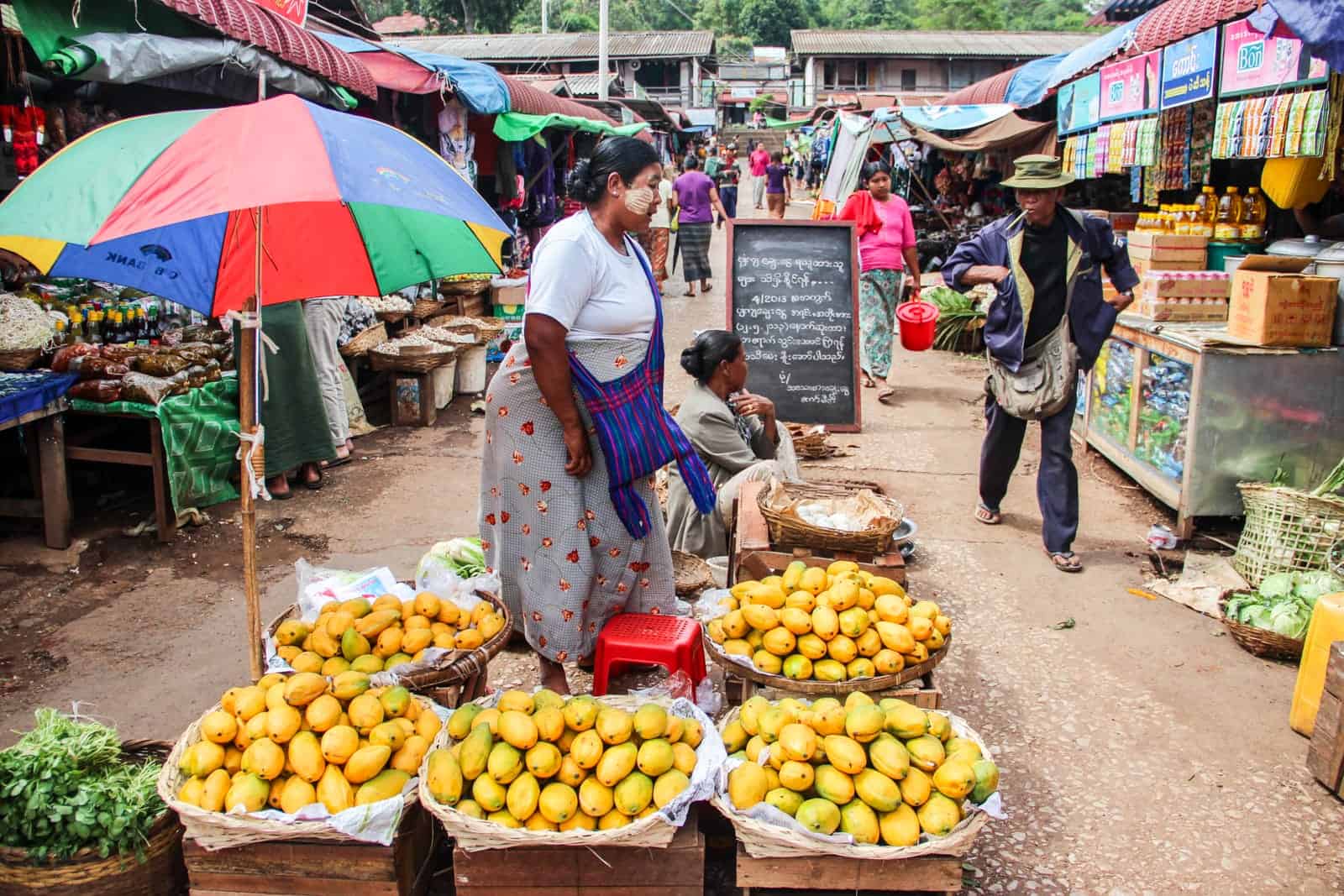
Responsible travel in Myanmar means putting your money straight into the hands of the local people
Choosing Accommodation in Myanmar
Guesthouses and Hotels
More or less every single traveller carries a Myanmar Lonely Planet (last updated in 2018), and whether you are a fan or not, this book has been thoroughly researched and is the only time I have fully relied on it as a bible rather than a reference point. However, given the regular increase in tourism which local businesses have capitalised on, prices have risen from what is printed. All accommodation and eatery options have been researched to provide travellers with a comprehensive list of places that are not government-owned.
Search and Book a Hotel in Myanmar
Are there Hostels in Myanmar?
Hostels are not as far and wide in Myanmar, although the big cities certainly have some options to choose from now.
Hostelworld now also lists a variety of hostels or similar style properties in Yangon, Bagan, Mandalay and Kalaw.
Accommodation in Remote Areas of Myanmar
In the more remote regions where I travelled, which were not listed anywhere, I relied on the knowledge of locals or the tuk-tuk driver who ended up taking us to the only place in town which held a ‘foreigner license’.
If you can, try to pair up with another traveller to cut costs – many guesthouses have double rooms, triples and dorms.
How to Travel in Myanmar – Transport Options
Internal Myanmar travel is cheap, slow but in the long run, effective.
Bus Journeys are the Main Option
The Myanmar bus is legendary in its own right. Buses are EVERYWHERE and will be the main form of transport you take to get you to almost any part of the country (where tourists are permitted). It is the most budget option, and I paid between 5,000 Kyat to 30,000 Kyat / $3 – USD 20 for a single ticket.
Your guesthouse can help you book your ticket in advance, and usually with the most trusted and decent company in that area. However, they may charge an extra couple of dollars as a form of the admin fee.
You can also take a chance and turn up at the local station to buy your ticket there. I only did this when my hostel had a better idea of schedules or called ahead and knew there would be adequate space. Since some bus stations are outside of the centre of a town or city, it doesn’t make sense to pay the price of an expensive taxi, to only have the haggle and get back again.
Some bus tickets now include a pick up from your accommodation. Double-check if that is the case.
Bus journeys in Myanmar are incredibly long, sometimes averaging 10-12 hours.
Comfort is not a factor. Myanmar’s buses do not have toilets on board (even the ‘luxury’ offerings) and air vents pump out wildly freezing temperatures. Make the toilet stop before you get on (although once in a real emergency my travel buddy did beg the driver to stop) and bring more than one layer with you.
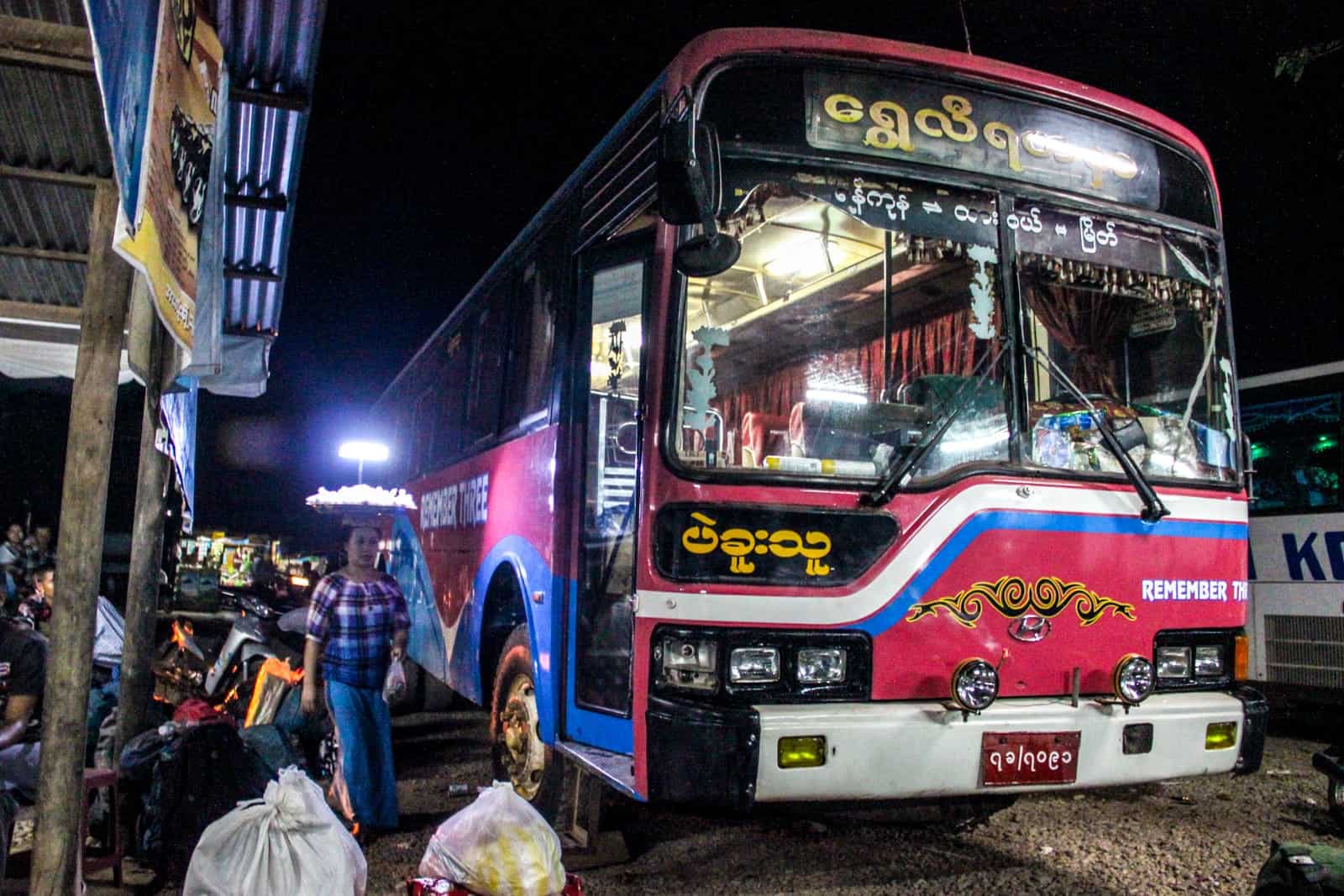
Get used to the Myanmar Buses. You will be using them a lot.
Night buses are not sleeper buses, even though these are the buses which bring you to your destination around 3 or 4 am. What’s more, some still play their funky local music CDs and cheesy music videos until the early hours of the morning. Pack your iPod, invest in some heavy-duty extreme earplugs or kindly ask for what was once amusing entertainment, now noise pollution, to be turned off.
Never ask a driver about the time of arrival. Due to superstitions based on a belief system of nats (spirits) that existed before Buddhism came to the fore, asking when you will arrive at a destination conjures up bad spirits and is taken seriously. The result? You won’t get an answer.
A comprehensive guide to Myanmar’s buses can be found here.
Taking a Taxi
Unless necessary, avoid taking a taxi in Myanmar since it can be a wallet-draining experience. There’s no metres or set prices, and you will spend a lot of time haggling a price rather than getting to your destination on time.
The only time you need a taxi is to and from an airport, where you have to suck up the extra budget and know you are being ripped off.
The only time a taxi can cost-effective and useful is if you hire a driver for a half or full-day. We did this in Yangon to get around some main sites and the price can average from between $20 – USD 30
However, with traffic gridlock in cities or smaller towns being compact, getting around by foot is usually the best and quickest option.
Horse and Cart
Prepare for the unexpected. When my night bus to Bagan arrived in the very early hours of the morning, my only option to get to my hotel was via horse and cart. There is still a haggling process to be had (not helpful when you are sleepy), but since this is the main form of tourist transport here it is only natural that they are waiting for new bus arrivals.

Transport in Bagan, the traditional way
Getting Off The Beaten Track in Myanmar
Not everywhere on a map of Myanmar is open for exploration.
The far northern, mountainous area of Myanmar, alongside the western Chin State and the far reaches of the southern Mon State and Tenasserim region are generally off-limits to tourists unless you have applied for a government visa in advance.
Applying for a Government Visa and Permits
Applying for a government visa in Myanmar usually has to be completed ahead of time, and can take months. It can also be costly since particular visas are not so commonplace yet. I have heard of some people applying for a government visa at the local bureau or via a tourism agency and it was processed and granted quickly. It can often come down to being lucky or depending on the particular area of Myanmar you wish to visit.
However, I and a few other travellers managed to get all the way south to Dawei and Myeik in the far south without a permit as we heard while in Mawlamyine that it had been open for a couple of months. It took days of long, arduous travel to get from place to place but it was a true adventure to visit areas that were untouched and which had hardly ever seen tourists.
Restrictions and Curfews
The only downside was that restrictions were still enforced in each area where we were faced with a 7 pm curfew in Dawei and couldn’t go out on a boat in Myeik (which is known for its archipelago of islands).
The restrictions mostly come down to the issue of safety for tourists, which locals have expressed is an absolute concern (for example, there is little in the way of insurance for the boats), although our gut instinct was that we were also being watched a little.
Solo Travel vs. Group Travel – Myanmar Tours
Not everyone wants to travel solo, and with Myanmar being a little more tricky to navigate and less-trodden than the typical Southeast Asia circuit of Thailand, Cambodia, Laos and Vietnam, you may want to consider joining a small group tour. This small group, two-week Myanmar tour with G Adventures takes you in a loop between Mandalay and Yangon, covering all the major highlights of the country along the way.
This includes riding local slow trains, taking scenic boat trips and embarking on a hill-tribe trek. The cost of this trip includes accommodation, some meals, and all transportation between each destination, including the internal flight.
So not only do you get to visit the very best of Myanmar, knowing that your money is being spent at local businesses and social projects, but you’ll have other travellers to enjoy it all with.
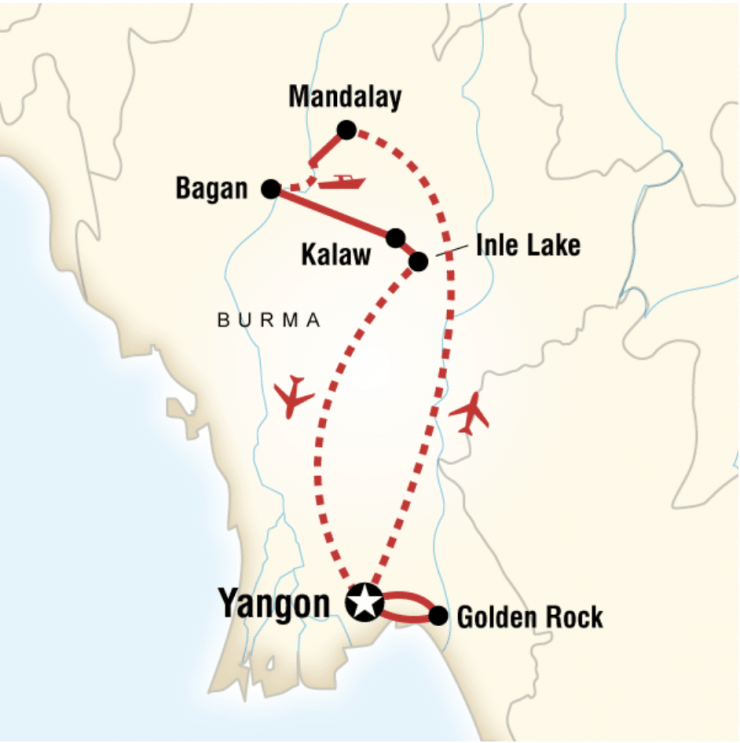
Discussing Politics in Myanmar – Is it OK?
You may read that it’s important not to start political discussions while travelling in Myanmar unless they are introduced into the conversation first. While this is true, the name ‘Aung San Suu Kyi’ passes the lips of a local before you know it and in public too. Politics is no longer limited to extremely private discussions (maybe the more heated ones are). A Burmese friend privately told me that it is ok to speak out against a situation or a person if you can back up your story. I am not sure how true this is or she is just a rebel.
I’ve been told of stories from Chinese and Indians who, although born in Myanmar, are unable to visit the land where their grandfathers and great-grandfathers are from as the government has made it difficult and expensive to obtain and visa/permit and a passport. I’ve heard terms of ‘stupid’ and ‘greedy’ used concerning the government and all without me asking.
The Burmese are always eagerly awaiting greater changes and wanted us to share with them what people in our country thought about Myanmar. As one of the first Myanmar travel blogs there on the ground, things were a little different back then as locals eagerly awaited a change in the form of Aung San Suu Kyi’s Democratic Party one day being elected, and her position of power being more cemented. Locals were all too keen to know what you thought and how much you knew, pointing out ‘The Lady’ and her father out on posters, book and newspapers. My limited conversation was always along the lines of:
“Aung San Suu Kyi. You know?”
“Yes. You love Aung San Suu Kyi. We love Aung San Suu Kyi.”
However, with recent political events, the topic of Aung San Suu Kyi and her policies might once again be the subject of very sensitive discussion. Since the Rohingya Crisis, a little hope has faded; Aung San Suu Kyi’s respect on the world stage has been stripped and her work at resolving this crisis has been seen as non-existent.
This detailed article from the New Yorker provides an interesting overview of ‘What happened to Myanmar’s Human-Rights Icon?”
Learning Burmese is Helpful, Not Essential
I always stand by my word that whether you are great at picking up languages or not, the two most important words you should always learn are hello and thank you. Travelling to Myanmar is just the same and learning these basic phrases certainly makes interaction with local Burmese people more special. Anything else you learn along the way is a bonus.
Burmese Phrases
The two most important phrases you need in Myanmar are:
Hello: Ming-gu-la-bah
Thank you: Jay-zu-de-bar-dee
Not only is it polite, but it is well received. Be prepared for most locals to giggle in response – they are not mocking you; they are just not expecting it.
Learning to Mime
While English is common in Myanmar, mainly in big cities, there will be endless amounts of situations where you will find that it’s not spoken at all. Now is your chance to bring out your hidden miming skills. My best one, after failing to find a toilet by flashing a piece of toilet paper, was to act out a squatting motion. Embarrassing as it was, it did the trick as well an inciting a few giggles from the locals. I also find wordless picture books handy in these situations too!
The Internet in Myanmar is VERY Limited
The internet in Myanmar is either non-existent or a sign proclaiming ‘wifi’ or ‘internet café’ is like stumbling upon the gold pot at the end of the rainbow and finding it empty. It will either not work or be slow. I found this more difficult, as a writer, but if you can, try to suck up the loss of fast, reliable and consistent communication with the outside world.
Negotiation, Haggling and Bartering is Not Common
In Southeast Asia, bartering is a given; a game that is often expected and enjoyed. Shopping in Myanmar will seem very different since bartering is almost unheard of. You can rarely negotiate your room rate (i.e. discount for more than one person) and I’ve had several looks of utter bewilderment in markets when I have lowered the price to start bartering. Unless the price is ridiculous, take it for what it is – you are helping out a local after all.
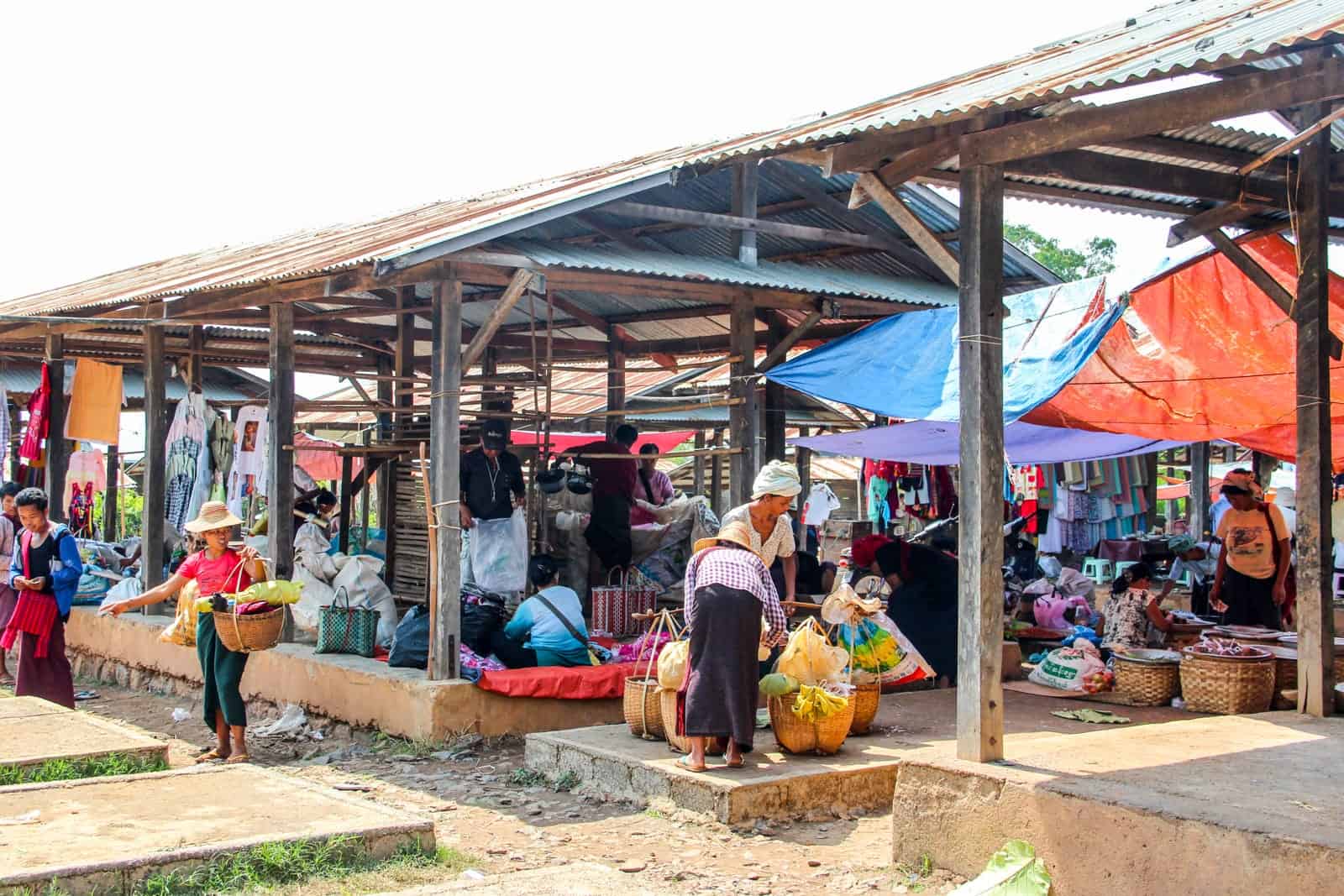
Good luck haggling in Myanmar!
Unusual Things About Myanmar
It’s those little cultural nuances that can make a place so fascinating, or which we could initially take offence to if we don’t know their meaning. Myanmar is no exception to such sights and encounters.
The Baffling Myanmar Time Zone
WHAT time is it in Myanmar? Why is there a 30-minute difference? Myanmar Standard Time is a little different. You see, while the rest of the world is plus or minus time ON the hour, Myanmar does it differently with half-hour time zones.
So don’t be baffled when you hear that Myanmar is 6.5 hours ahead of GMT (Greenwich Mean Time) and that the country does not also observe daylight savings time. No clocks changes here.
Don’t Be Offended When Locals Make a Kissing Noise
This is in no way a derogatory sound aimed at you, but the Burmese way of calling attention. It’s rather fascinating and you realise, when trying to practice yourself (yes, I did), that you can’t quite do it as loudly and precisely as them.
Dodge the Red Spit
The majority of Burmese locals chew on leaves containing a mixture of tobacco and betel nut which turns their mouth and teeth red. They are neither bleeding nor spitting out blood.
Part of this snacking process involves the regular need to spit out the juices – anywhere and everywhere – so dodge the red spit showers and don’t scour in disgust. This is how it is on all Myanmar trips. While pavements and walls are stained with it, you don’t want to be.
Want to Travel Myanmar? Pin It!
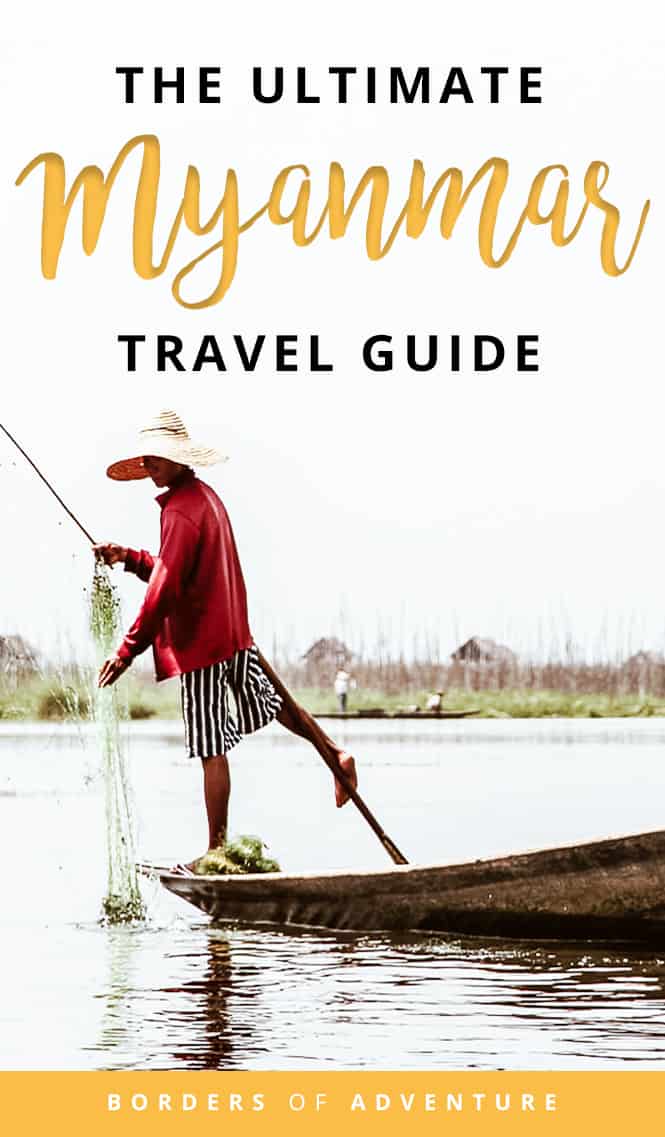
Any plagiarism of this Myanmar travel blog or travel any of its descriptions used on other sites and blogs without attribution is not information authorised by myself for use. Know your source.
The post Ethical Myanmar Travel Guide: What To Know Before You Go appeared first on Borders Of Adventure.
from Borders Of Adventure https://www.bordersofadventure.com/myanmar-travel-guide/
VietNam Travel & Food Magazine Vina.com offers News✅ Travel info✅ Food Recipes✅ Photos✅Restaurant Guide at Vina.com https://vina.com/travel/nightlife/ https://vnfoodandtravelblog.blogspot.com/



0 Nhận xét